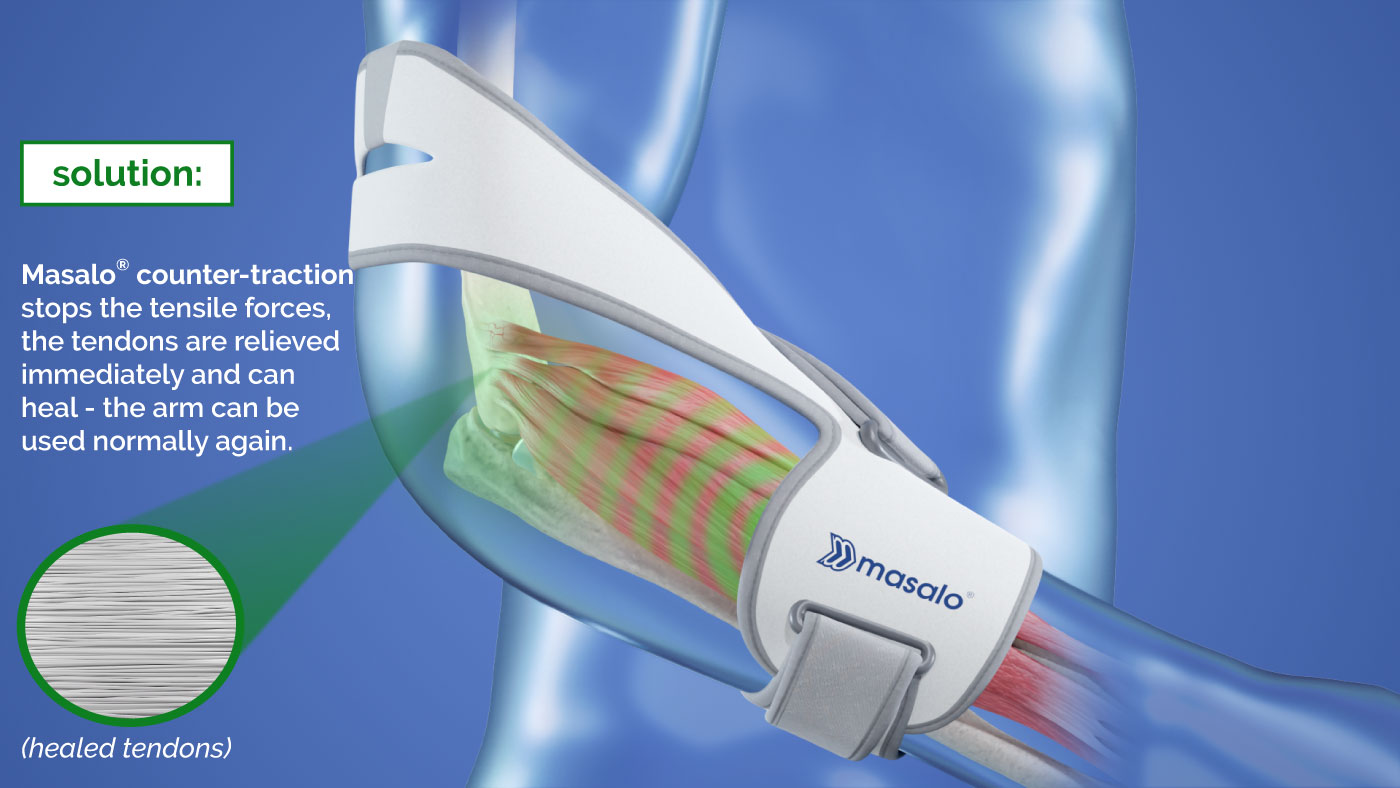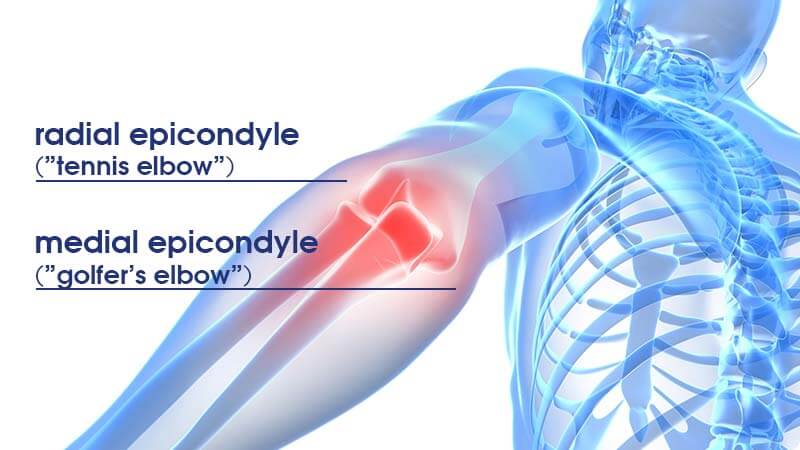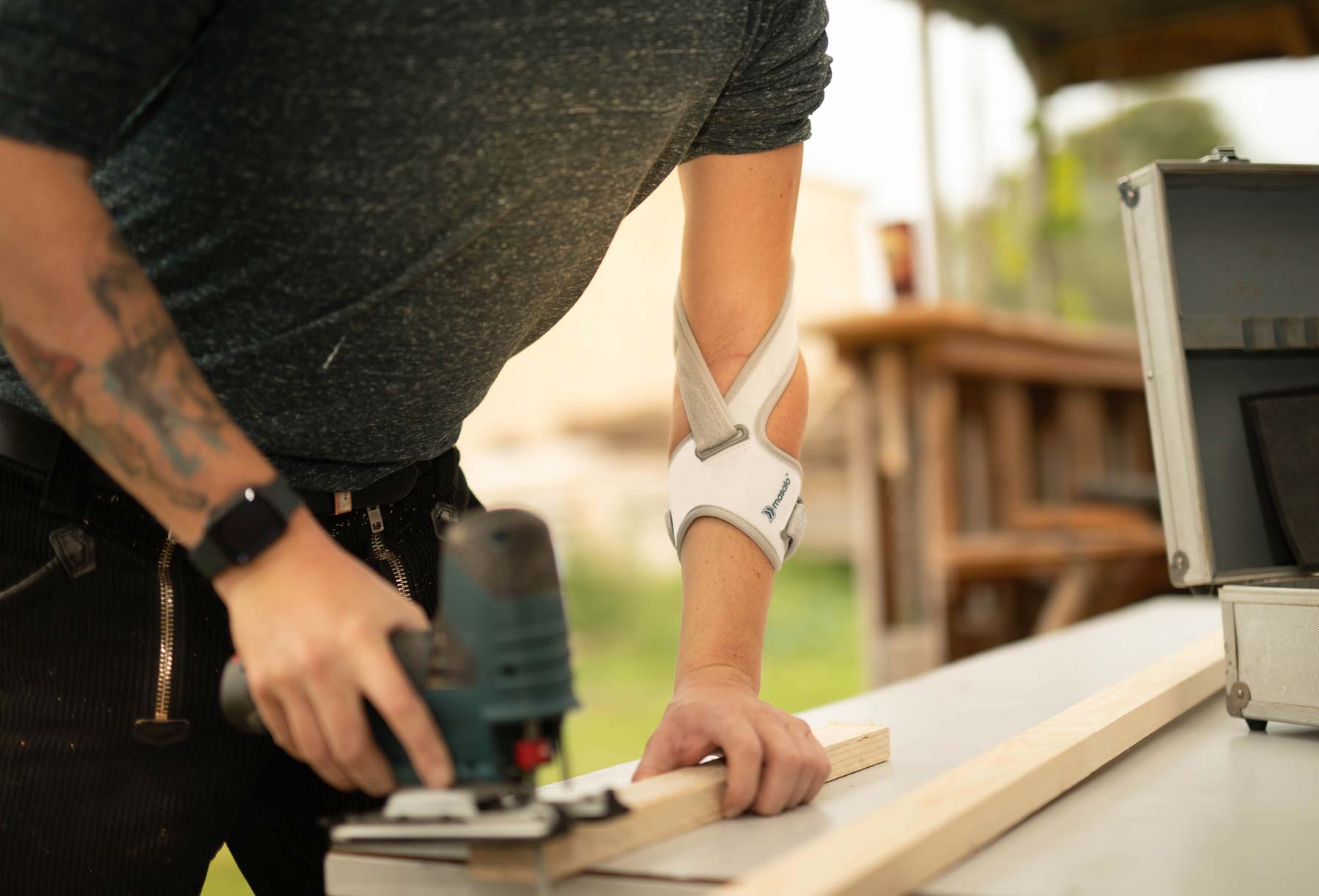On this page you will learn everything about epicondylitis, its prevalence, treatment methods, medical explanations and much more.
Short menu / Topic overview
Development of epicondylitis
The so-called tennis elbow or golfer’s elbow (epicondylitis) is caused by tensile forces of the hand extension and flexor muscles and their tendons. These negative tensile forces permanently affect the tendon insertions at the elbow and cause injuries there in the form of microtears.
More detailed information and sources can be found further down this page.

Effective help for epicondylitis
So if tensile forces are the cause of tennis elbow and golfer’s elbow, they should simply be counteracted and rendered harmless. This is the idea behind our unique Masalo Cuff MED. It creates a counter-traction and relieves the tendon insertions immediately and sustainably.
If you would like to know exactly how this principle of action works, simply click here.
Explanation of terms
Tennis elbow, golf elbow, mouse elbow – these are all colloquial terms for epicondylitis.
In medical terminology, the injury is also referred to as epicondylopathy, epicodylosis or epicondyalgia. (Source: Wikipedia)
The designation tennis elbow and golfer’s elbow depends on which muscle part and which tendon insertion is affected.

For the outer tendon, at the radial epicondyle, the common name is tennis elbow; for the inner tendon, at the medial epicondyle, the term golfer’s elbow or golf elbow is used.
The name tennis elbow, or golfer’s elbow, incidentally results from the fact that many tennis players and many golfers are confronted with this injury during their active sports careers. The force of the many hits and a possible incorrect racket/club position contribute to the large spread of the injury in sports circles.
A newer name for epicondylitis is mouse arm, as more and more people are exposed to one-sided stresses from computer work.
Just like tennis elbow and golf elbow, the mouse arm in particular is associated with the mechanisms of development of repetitive strain injury syndrome.(RSI syndrome – injury caused by repeated stress or strain. (Source: Wikipedia)
Spread and disease duration
There are numerous dissertations, investigations, studies, etc. on the points of prevalence and duration of the disease, but unfortunately they do not come to a uniform conclusion. There is only agreement that there are currently no really valid figures.
Therefore, we would like to give only a small overview of the extensive information collected by us on the current state of knowledge, whereby we will limit ourselves only in extracts to a few sources.
Spread
Tennis elbow or golfer’s elbow is the most widespread disease/injury in industrialized nations after back problems.
The prevalence (proportion of people suffering from the disease per year) is reported to be between 1.5% and 6% of the general population. Thus, up to 40 million people suffer from epicondylitis in Europe alone.
The incidence (new cases per year) is even put at 1% to 9%. It is assumed that only about 50% of those affected seek medical treatment at all, or discontinue it prematurely after a few failures.
Epicondylitis is most common in the 45-54 age group, and “tennis elbow,” or injury to the radial epicondyle, is statistically 5 times more common than “golfer’s elbow,” or injury to the medial epicondyle.
There are also occupational groups in which this injury/illness is significantly more common:
- Forest workers: up to 29%
- Assembly automotive industry: up to 20%
- Cooks: up to 10.5%
- Plastic surgery: up to 13.1%
Duration of illness
In general, the average duration of illness is assumed to be 6 to 48 months. From a duration of 6 months onwards, the epicondylitis is already classified as chronic.
Work loss / recurrence
According to figures from the CSST, Quebec (2009), the average incapacity to work is 83.7 days and the risk of recurrence is 10.6% for certain occupational groups.
So you realize, epicondylitis is common and requires no short period of time to heal.
Tennis elbow? Golfer’s elbow?
What is that exactly?
With each movement of the arm, fingers or wrist, tensile forces from the forearm muscles and tendons act on the tendon insertions (epicondyli) at the elbow.
Unaccustomed high loads, strenuous or repeated movements of the arm can thus lead to injuries in the form of microtears on these tendons, which can then become inflamed. (Source: Netdoktor), (Source: Wikipedia)
The pain can occur at rest and also with exertion, starting from the injured tendons and/or due to inflammation.
Main cause of the epicondylitis
Just like the intensity of the pain, the trigger of the epicondylitis is individual and different. Affected are active people such as craftsmen, office workers (PC work; mouse arm), warehouse workers, retail workers, housewives, athletes, hobby gardeners, etc.
Knitting, gardening or shoveling snow and the like, can also trigger this treacherous disease.
Epicondylitis is often caused by an unusual and unfamiliar activity, such as moving, major house cleaning, construction work, special tasks at work, slipping on snow and ice and propping it up with your hand, or many other things. Once the microtears have developed at the tendon insertions, they become increasingly strained and irritated by everyday stresses, such as shaking hands, moving the hand and fingers, brushing teeth, combing hair, or professional and sports-related movements.
The vicious circle begins and the tensile forces do their work.
Incidentally, both tennis elbow and golfer’s elbow have the same causes; the stressful activity is then the decisive factor for the occurrence of the injury to the medial or radial epicondyle.


Effects of epicondylitis
For patients with tennis elbow or golfer’s elbow, the diagnosis of epicondylitis often means a harsh impact on many areas of life and a significant loss of quality of life.
Depending on the progress and severity of the injury/illness, even simple everyday actions such as lifting a coffee cup, driving a car, setting the table or shaking hands can be associated with severe pain.
The main symptom is a stabbing pain in the area of the elbow, which, depending on the intensity, can also radiate towards the shoulder and hand.
Depending on whether tennis elbow or golf elbow is present, these symptoms may be caused by twisting movements or the like on the outside or inside of the elbow.
Logical therapeutic approach against epicondylitis
Usually, the first treatment of tennis elbow is a cortisone injection against the inflammation. Which, however, does not work against the actual cause and physical forces. Conventional braces or bandages are often prescribed for this purpose. These tennis braces, supports, clasps and orthoses all work on a compression principle. By applying pressure to the muscle bellies, the tendons should be relieved.
The Masalo Cuff works very successfully according to a completely different and novel principle.
The muscles and tendons of the forearm are “attached” to the two tendon insertions at the elbow. Every movement of the fingers, muscles and arm exert tensile forces on these two points. When overstressed, injuries occur there in the form of microcracks / microtears.
You can see the action of these tensile forces on your own arm:
Place the arm on a table and move the fingers, you will see the movement at the outer epicondyle.
Or simply close your hand into a fist a few times and open it again. If you now grab of the lower part of your forearm in the area of the tendon insertions near the elbow with your other hand, you will feel the muscles – the tensile forces – working.
Tensile forces? Counter-traction!
This is exactly what the Masalo Cuff does. The counter-traction system provides immediate and lasting relief to the affected area. The tendons are protected, the pain is relieved and healing is positively supported – although the arm can still be used normally. The unique design of the Masalo Cuff allows it to be worn permanently, day and night.
This new tennis elbow treatment directly combats the cause and follows a logical principle as an alternative or additional therapy. The effect is immediately noticeable.
How does the Masalo Cuff work?
The Masalo Cuff works with the proven Masalo counter-traction principle of action, which is still unique in the field of epicondylitis aids.
Over 60,000 customers have already been able to defeat their injury with the help of our The Masalo Cuff is registered in the German Hilfsmittelverzeichnis under the HMV-number 23.08.04.0042. For information on how to purchase the Masalo Cuff by prescription, please visit our info page.
The comfortable forearm cuff of the Masalo Cuff is placed approximately in the middle of the forearm and is fixed with the high-quality and very durable Velcro fastener.
The upper arm strap is then also attached with Velcro and adjusted according to the activity and load.
Due to the unique and patented design, the upper arm strap holds with every movement. The tensile forces are reduced or stopped completely by the proven counter-traction principle, and the affected area is relieved. The negative tensile forces are diverted to the upper arm strap free of negative side-effects.
This gives the affected tendons a chance to heal, although the arm can still be used and loaded normally.
The Masalo Cuff can be worn preventively and provide immediate relief for acute and chronic epicondylitis.
The cuff can and should be worn 24 hours initially, if possible, so that the tendons remain permanently relieved – even at night – and sleep is not disturbed by uncontrolled movements.
Unlike “normal” bandages or epicondylitis braces, the Masalo Cuff does not affect blood circulation because it does not use compression (pressure) and can therefore be worn permanently.
If worn at work or during sports, it can promote the strength development.
As the experiences of other sufferers show, with the Masalo Cuff it is even possible to return to pain-free sports despite epicondylitis/epicondylopathy.
When playing tennis, the experience of other customers has shown that the racket posture is improved. The stabilization of the elbow leads to a higher impact force. Thus, sufferers with the cuff have benefited in other sports such as weight training, javelin throwing, handball and volleyball.
Show sources of this page
Your Subtitle Goes Here
Uni Regensburg:
https://epub.uni-regensburg.de/30983/1/Thesis.pdf
ASU – Case-Control Study:
https://www.asu-arbeitsmedizin.com/Archiv/ASU-Heftarchiv/article-709667-110576/fall-kontrolle-studie-zur-bestimmung-von-risikofaktoren-der-lateralen-epikondylitis-.html
BARMER GEK Remedies and Aids Report 2012:
https://www.pflegegesellschaft-rlp.de/fileadmin/pflegesellschaft/Dokumente/Dokumente_2012/BARMER_GEK_Heil-und-Hilfsmittel-2012_-_September_2012.pdf
ORDER NOW!
Order 100% safe and convenient in our online store!
Free shipping within Germany!
 Watch TV reports!
Watch TV reports! shop@masalo.eu
shop@masalo.eu +49 (0) 4131 - 727 15 97
+49 (0) 4131 - 727 15 97